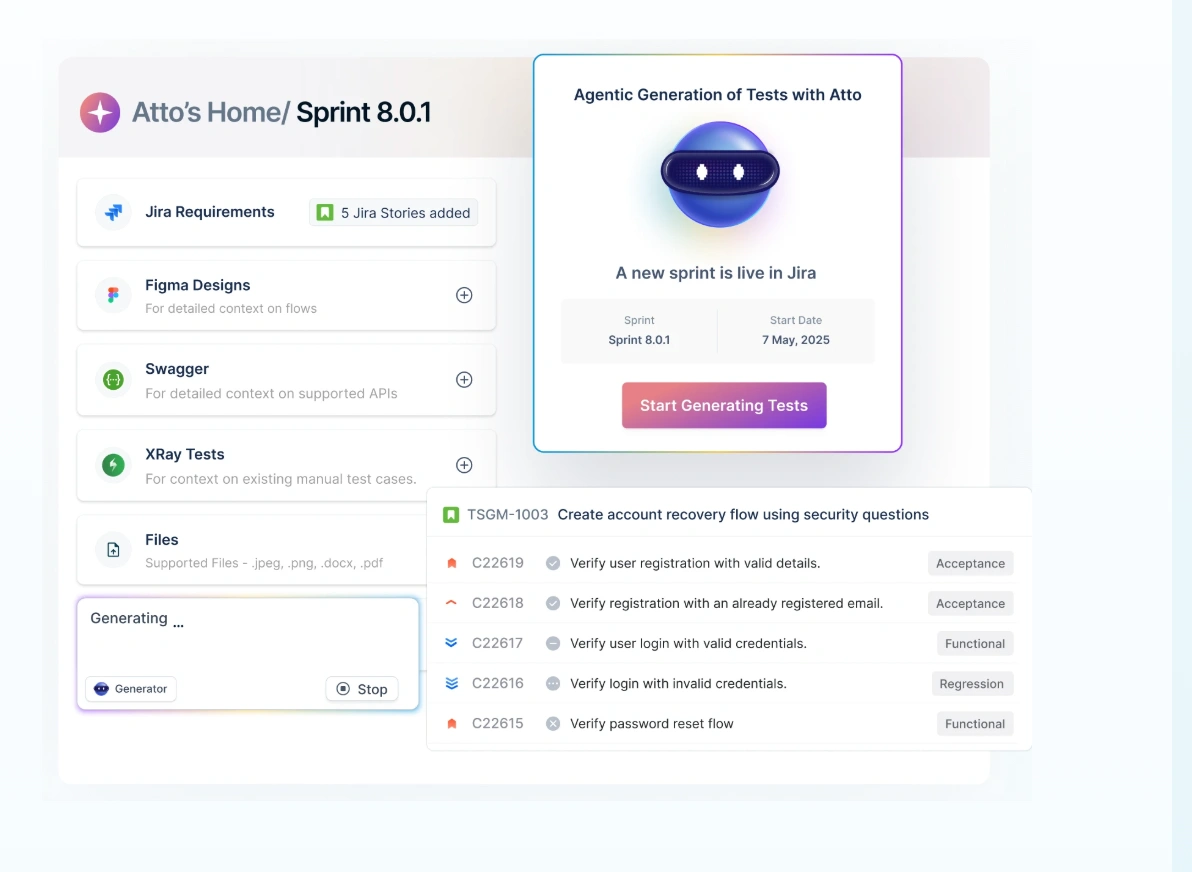Test management is one of the most critical components in the software testing lifecycle. Without a centralized system to organize, track, and maintain your tests, it would be difficult to improve coverage, regressions, or quality trends. Fortunately, there are a number of test management platforms available. In this blog, we’ll explore Qase, a modern, cloud-based, code-friendly solution, and introduce an alternative, Test Management by Testsigma, an intelligent, low-code platform.
Table Of Contents
What is Qase?

Qase is a powerful, cloud-native test management platform that supports manual and automated testing workflows. It allows QA teams and developers to create structured test cases, organize test suites, track execution, and integrate automation results, all in one place.
The platform is well-suited for Agile and DevOps teams who need a centralized solution with flexibility, detailed analytics, and seamless integrations with tools like Jira, GitHub, and CI/CD pipelines.
While Qase supports manual testing using custom reporters or APIs, it is primarily known for its ability to aggregate results from automation frameworks such as Pytest, TestNG, JUnit, Playwright, and Cypress. It also includes an AI assistant, AIDEN, to help generate or enhance test cases.
Features of Qase
Here are some of the key features that make Qase stand out:
- Test Case Management: Create reusable test cases with step-by-step instructions, parameters, attachments, and custom fields.
- Test Suites & Plans: Organize test cases into suites and test plans for better execution strategy and planning.
- Manual & Automated Execution: Track results from both manual test runs and automated test executions.
- Rich Reporting & Dashboards: Visualize pass/fail trends, coverage metrics, defect linkage, and test run analytics.
- CI/CD Integration: Native support for Jenkins, GitHub Actions, GitLab, and more to sync automation results.
- Defect Management: File, track, and link bugs directly from failed tests and integrates with Jira, Redmine, etc.
- Requirement Traceability: To ensure complete coverage, map test cases to user stories, epics, or requirements.
- Role-Based Access Control: Manage access and permissions securely across large teams.
- API Access: Expose test data via REST and GraphQL APIs for custom workflows.
- AI Assistant: Help generate and refine test cases using their AI assistant AIDEN.
Check out the comparison between Testomat Vs Qase
Advantages of Qase
- Developer-Friendly: CLI tools and framework integrations make it ideal for teams with in-house automation.
- Scalable & Cloud-Based: Multi-user support, project separation, and scalable test data handling.
- Collaborative UI: Intuitive interface for manual testers with comment threads, version history, and shared steps.
- Automation Aggregation: Import results from dozens of frameworks using ready-to-use reporters.
- Powerful Analytics: Real-time dashboards help identify trends, regressions, and gaps in test coverage.
- Affordable for SMBs: Transparent pricing suits startups and growing teams.
Limitations of Qase
While Qase is a strong test management tool, it has a few limitations to consider:
- No Native Execution Engine: Qase does not run tests; you need an external automation setup or CI pipeline.
- Real Device Lab Not Included: No in-built support for running tests on real mobile or browser devices.
- AI Still in Beta: AIDEN is promising but has limited capabilities compared to more mature AI systems.
- No Visual Test Recorder: Test case creation is manual or imported, and lacks low-code creation tools.
- Limited Test Maintenance Support: No self-healing or flaky test detection out of the box.
Check out the top in the market Alternatives to Qase
How to Choose the Best Test Management Tool?
Here are the most common pain points faced by QAs in test management
- Scattered Test Data: Test cases are often duplicated across spreadsheets, documents, or email threads, creating confusion and a lack of visibility. Without a centralized system, tracking ownership and progress becomes difficult.
- Inconsistent Test Execution: Variations in test steps, formatting, or expected results lead to conflicting outcomes, making it harder to reproduce or resolve bugs effectively.
- No Version Control: Storing test cases in shared folders or Excel files does not create a version history. This leads to overwriting issues, outdated test steps, and loss of critical context over time.
- Slow and Tedious Maintenance: Maintaining test cases is time-consuming, especially for large-scale or regression test suites. As test coverage increases, manual updates become a bottleneck.
- Execution Time Increases: Manual test execution, especially during every sprint or release, significantly slows down the release cycle, affecting go-to-market speed.
The best test management tool would solve the above pain points by offering,
- AI-Powered Testing With Agent Support – AI agents help automate tasks such as test creation, execution, maintenance, and bug reporting.
- Automated Regression Test Suites – Automate critical regression suites and run them in parallel across different environments and devices. This reduces manual effort and ensures you never miss a bug before release.
- Self-Healing Tests – When UI elements change, such as a button label or selector, self-healing mechanisms automatically adjust the tests. This eliminates the need for constant script maintenance and keeps your automation stable.
- Bug Tracking – With integrated defect management, you can log, link, and resolve bugs directly from failed test runs, eliminating the disconnect between testing and development tools like Jira or GitHub.
- Reduced Test Flakiness – Smart platforms identify and isolate flaky tests, allowing you to maintain reliable pipelines. Flakiness is flagged automatically, helping QAs focus on real issues, not false alarms.
- Enhanced Test Coverage – Use test coverage dashboards and traceability maps to track which requirements are tested, which are at risk, and how your testing evolves sprint after sprint.
How Can Test Management by Testsigma Help with Efficient Test Management?
Test Management by Testsigma is an agentic AI-powered test management tool with advanced capabilities. Unlike Qase, Test Management by Testsigma’s AI agents can act like your QA coworker and remove the hassles of manually maintaining test cases. With the intelligent AI agent, Atto, test management becomes faster and wiser.
Here are agents that make test management autonomous:
- Sprint agent – Automatically plans your tests once a Jira sprint starts by detecting the new sprint.

- Generator agent – Create test cases with inputs from user requirements, Figma designs, PDFs, docs, screenshots, prompts, images, and videos.
- Runner agent – This agent validates the created tests and helps with running your test cases within the browser, ideal for sanity checks and low-effort test execution.
- Bug reporter agent – Bugs are intelligently identified and seamlessly integrated with issue trackers like Jira to reduce triaging time and improve bug lifecycle efficiency.
Apart from agentic capabilities, Test Management by Testsigma also offers the following features,
- Self-healing tests – Tests get updated automatically whenever updates are made.
- Jira Integrations – Supports native integration with Jira and also offers two-way sync for requirements traceability.
Conclusion
While Qase is made with much technical expertise, Test Management by Testsigma is agile and futuristic. Ultimately, the organization must choose a tool that matches its business needs.


